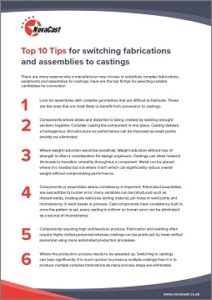
There are many reasons why a manufacturer may choose to substitute complex fabrications, weldments and assemblies for castings. Here are the top 10 tips for selecting suitable candidates for conversion.
- Look for assemblies with complex geometries that are difficult to fabricate. These are the ones that are most likely to benefit from conversion to castings.
- Components where stress and distortion is being created by welding wrought sections together. Consider casting the component in one piece. Casting delivers a homogenous microstructure so performance can be improved as weak points (welds) are eliminated.
- Where weight reduction would be beneficial. Weight reduction without loss of strength is often a consideration for design engineers. Castings can allow material thickness to transition smoothly throughout a component. Metal can be placed where it is needed but not where it isn’t which can significantly reduce overall weight without compromising performance.
- Components or assemblies where consistency is important. Fabricated assemblies are susceptible to human error; many variables can be introduced such as missed welds, inadequate weld size joining material, pin holes in weld joints and inconsistency in weld beads or process. Cast components have consistency built in; once the pattern is set, every casting is uniform so human error can be eliminated as a source of inconsistency.
- Components requiring high skill levels to produce. Fabrication and welding often require highly skilled personnel whereas castings can be produced by lower-skilled personnel using more automated production processes.
- Where the production process needs to be speeded up. Switching to castings can help significantly. It is much quicker to produce multiple castings than it is to produce multiple complex fabrications as many process steps are eliminated.
- Looking for economies of scale? It is difficult to achieve these with fabricated assemblies as the same process needs to be repeated for each assembly using similar materials and labour. Multiple castings can be made at one time delivering significant economies of scale.
- Where material wastage is an issue. Casting uses material more efficiently as there is less waste and more recycling of waste back into the production process.
- Where design is important. More aesthetically pleasing designs are possible using castings as designers can include unique shapes, features and curves.
- Where uniform directional strength is required. Wrought metal (rolled or forged) exhibits directionality (anisotropy) where a component has strength or ductility in one direction but its transverse properties are lower. Cast products are isotropic, which means that they deliver consistent strength and ductility in any direction. As castings are typically isotropic, uniformly heat treated and more stress relieved than a fabrication they tend to have longer fatigue lives and allow more deformation without sudden failure.
To discuss your requirements, call a member of NovaCast’s team on +44 (0) 1225 707466, send us a message here or email sales@novacast.co.uk.
